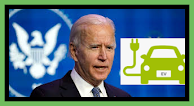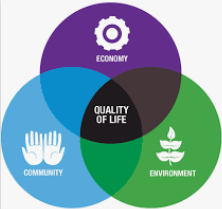Elected
officials have talked about it for years, but the Democratic-controlled
Congress appears on the verge of tackling the country’s infrastructure problems. President Biden unveiled a plan for

putting over $2
trillion into upgrading the nation’s crumbling bridges, roads, seaports,
airports, transportation facilities, housing, broadband, power grid
deficiencies, and school construction. Biden wants a good part of the money

allocated to
clean
energy projects, like
support for electrical vehicles, wind
generated power, and solar energy. He
called his plan a “once-in-a-generation investment” in the United States.
A Festering Problem
Only the
most uninformed would suggest the nation doesn’t have an infrastructure
problem. The
problem developed over a long period, as the federal, state, and
local governments neglected maintenance and replacement of facilities,
especially transportation-related, built years ago. Donald Trump claimed he’d
do something about the problem and promised numerous “infrastructure weeks” during
his time in the White House.
It never happened because (1)Trump cared
much more about tax cuts for the
wealthy and (2) his only ideas about infrastructure involved tax credit schemes
that would benefit his wealthy donors. He did not propose injecting significant
government resources into real projects. Biden has a different idea.
Objective observers of the American
socio-economic and political scene have been warning about dangers inherent in
the failure to address this
The issue goes beyond repairs.
Infrastructure
spending, as economist Joseph Stiglitz points
out, can stave off “recession in the short run while spurring growth in the
long run.” In other words, a plan like
Biden’s could spur long term economic growth as well as repair crumbling
infrastructure. Biden, in fact, calls his proposal The American Jobs Plan.
The Plan
Biden’s
proposal allocates almost $600 billion for transportation related projects,
including $115 billion for road and bridge work, $80 billion for railways, and
$85 billion on public transit. The
plan
proposes investing $174 billion in projects related to electric vehicle
development. This means building charging stations, creation of better
batteries, retooling factories, and providing incentives that encourage
automakers to shift production from fossil fuel vehicles.
The plan also emphasizes people-related investment, like workforce innovation, pandemic preparedness, and domestic
manufacturing assistance. It proposes,
for example, allocating $400 billion for community-based care for the elderly and
people with disabilities. It would inject $180 billion into research and
development, an area in which the United States once excelled but has fallen
behind other nations, especially China.
The Politics
Without
congressional approval the plan goes nowhere. Battle lines formed quickly after the
president unveiled his proposal. Republicans immediately voiced
opposition. They claimed the plan is too
big, spends too much money, and most of all, they object to rolling back the
Trump tax cuts, an essential element of how Biden would finance the
plan.
Trump’s tax cuts reduced the corporate tax rate from 35% to 21%. Biden
proposes increasing the rate to 28%, which supposedly would raise $2
trillion
dollars over ten years. Democrats were not all on board, at least not initially. The price tag exceeded the preferences of a
few and others didn’t think there was enough emphasis on certain things. Some,
like
New York Congresswoman Alexandria Ocasio
Cortez, arguedthe
plan isn’t big enough. She says the country needs a $10 trillion program over
ten years. Still, house Democrats said
they hope they can pass the program during the summer. Things are dicey in the
senate, where likely unified Republican opposition (already forecast by
Mitch McConnell) could
topple the plan when added to reluctance from a few conservative Democrats.
The Ideology
The fight
is also ideological. On the one side are those who feel that government has a
significant role to play in improving the quality of life for
Americans. On the other side are those who want limited
government and fear that if government is successful in a matter as important
as infrastructure, there might be a “…kind of halo effect that links all forms
of government activism…that we need public policies to reduce inequality…expand
access to health care.” See
Paul Krugman’s 2021 book,
Arguing With Zombies Economics, Politics,
And The Fight For A Better Future.
Benefit/Detriment
The expected fight over the
president’s plan sets up a classic benefit/detriment battle in which the
combatants argue over what Americans want and need. Advocates of the White House proposal will
argue the United States simply can’t put off any longer doing something about
the infrastructure problem. Things are going to hell in a handbasket (or already
have). The needs are simply too great. In Houston, where one of us (Rob) lives,
for example, five bridges along freeways are among the 250 most heavily-traveled, yet structurally
deficient, bridges in the nation. Meantime, the climate crisis continues as this
winter’s storms demonstrated. Biden’s plan addresses that problem with an
aggressive effort at promoting clean energy.
But, the opponents will argue
government spending, and the tax increases needed to fund it, are not the way we
should attack this. While admitting the
problem, they at least say they want a private, industry focused effort,
perhaps with
That’s the debate we’re certain to
have. Hopefully
we can have it on the merits.


















No comments:
Post a Comment